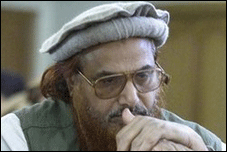|
Image may be NSFW. Clik here to view. 
|
| Lashkar-e-Taiba leader Hafiz Saeed. |
Osama bin Laden was in close contact with Hafiz Saeed, the wanted chief of Lashkar-e-Taiba (LeT), and helped plan the 2008 Mumbai attack, according to a report in the Hindustan Times. Citing Bruce Riedel, a former advisor to President Obama on Afghanistan and Pakistan, the Hindustan Times says that documents recovered in bin Laden's Pakistani safe house prove the extensive relationship between al Qaeda's deceased emir and LeT.
"The documents and files found in Abbottabad showed a close connection between Bin Laden and Saeed, right up to May 2011," Riedel told the newspaper. Riedel added that the captured files "suggested a much larger direct al Qaeda role in the planning of the Mumbai attacks than many assumed" and bin Laden may have seen surveillance reports prepared by David Headley, the LeT operative who scouted out locations for the Mumbai siege.
The revelation of Hafiz Saeed's ties to bin Laden led the US to offer a $10 million bounty for the LeT chieftain, according to the report. [For more on the reward, see LWJ report, US offers $10 million bounty for capture of Lashkar-e-Taiba chief Hafiz Saeed.]
Such collusion would hardly be surprising. Al Qaeda and LeT have had a strong relationship for more than two decades. Abdullah Azzam, a mentor to bin Laden and co-founder of Maktab al Khadamat, a forerunner to al Qaeda, also helped found the LeT organization. In more recent years, the LeT's network helped al Qaeda operatives flee Afghanistan in late 2001 and early 2002 after the fall of the Taliban. Al Qaeda terrorists have trained in LeT camps, and LeT members have fought alongside al Qaeda and the Taliban against Coalition forces in Afghanistan.
Ilyas Kashmiri, who helped plan the 2008 Mumbai assault, worked for multiple organizations during his tenure, including al Qaeda, LeT, and Harakat ul Jihad al Islami (HUJI). Headley answered to Kashmiri, who was reportedly killed in a June 2011 drone strike, as well as two other handlers in Pakistan.
Documents raise new questions
Assuming bin Laden's files show what has been reported, the documents raise new questions about the former al Qaeda master's ties to elements of Pakistan's military and intelligence establishment.
Lashkar-e-Taiba is a longtime Pakistani proxy that works closely with, and under the direction of, the Pakistani Inter-Services Intelligence (ISI) agency. The ISI used LeT to wage a proxy war against Indian forces in Kashmir during the 1990s. LeT head Hafiz Saeed has long received the ISI's protection and backing, even after the Mumbai attacks drew international condemnation. Saeed has frequently been detained as a show of cooperation by Pakistani authorities, only to be released and then quickly returned to his terrorist business.
Saeed is so close to the Pakistani military and intelligence establishment that, according to Press Trust of India, he condemned the recent reward offered by the US during a press conference held at the "Flashman Hotel in the garrison city of Rawalpindi, located a short distance from the Pakistan Army's General Headquarters."
"I am not hiding in caves and mountains, I am here in Rawalpindi," Saeed told those in attendance. Saeed challenged the US to kill him in the same manner as Osama bin Laden.
If Osama bin Laden was in regular contact with Saeed up until his demise at the hands of Navy Seals in May 2011, it is difficult to believe that members of the ISI did not know about it.
During an American trial of one of his co-conspirators last year, Headley testified that two ISI-connected handlers worked with him in the plot. Sajid Mir and a man known as Major Iqbal both worked with and directed Headley throughout his missions.
Intercepted phone calls show that Mir directed the Mumbai attackers. Mir's ties to the ISI were discussed at length in an exhaustive study of the Mumbai siege prepared by Sebastian Rotella for ProPublica and the Washington Post.
Rotella reported that Jean-Louis Bruguiere, a French judge who is renowned for his counterterrorism work, investigated the LeT's operations and concluded "that Sajid Mir was a high-ranking officer in the Pakistani Army and apparently also was in the ISI." Mir achieved the rank of major before leaving the Pakistani Army for some unknown reason.
Obviously, the man known as "Major Iqbal" received that title because he, too, became a major in the Pakistani Army. "US and Indian anti-terrorism officials suspect Major Iqbal was a serving ISI officer and a liaison to Lashkar," Rotella reported. Iqbal reportedly gave Headley $25,000, which was used to facilitate the surveillance of potential targets in Mumbai.
And if this most recent account in the Hindustan Times is right, then the surveillance reports paid for by an ISI man ended up in the hands of Osama bin Laden.
While ISI-connected operatives were clearly involved in the Mumbai plot, questions remain about how much the highest-ranking officials in the ISI knew about it. The same type of debate was unleashed in May 2011, after Osama bin Laden was found living next to an elite Pakistani military academy. The ISI has multiple wings, with the T-wing considered vastly more friendly to the US than the S-wing, which manages the Pakistani military and intelligence establishment's sponsorship of terrorist groups.